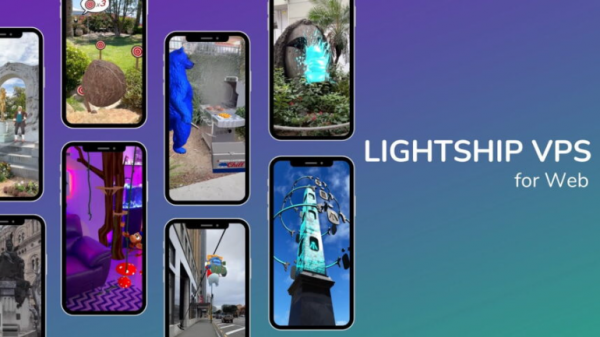Niantic Visual Positioning System Transforms Your World into an AR Game
Niantic’s “Visual Positioning System” allows augmented reality users to interact with persistent and ‘global scale’ AR content. The Lightship VPS is now available for the web and runs directly on the browser enabling users to have the real-world metaverse directly on the browser.
Popular Augmented Reality games such as Pokémon Go have mostly relied on GPS data which is not 100% accurate and does not accurately locate players on virtual maps. The deployment of the Lightship VPS AR tools for the web will enable web browsers to anchor immersive experiences in thousands of locations across the globe.

Niantic’s Visual Positioning System (VPS) allows users to have interactions via global scale persistent AR content on their mobile devices. The VPS is a new type of location map that can be used by developers for augmented reality experiences by delivering location-based and persistent content that is also synced for all users on the platform.
The Visual Positioning System map has been built from scanned visual data and is said to be more accurate than GPS. According to Niantic, the VPS provides up to a “centimeter-level” of accuracy when one is pointing to the location and orientation of other users in relation to one another. The VPS technology is similar to other large-scale visual positioning technologies that are being built by Snap and Google.
Niantic promised that its VPS technology will be global-scale although it is still a long way from there. When it was announced in May this year, there were 30,000 public locations where the VPS was available. These locations were spread across major global cities including London, San Francisco, Tokyo, New York, Los Angeles, and Seattle. These include locations such as paths, parks, landmarks, and local businesses among others.
The VPS can anchor players at an accurate location and permanently on a shared 3D map.
Niantic’s Visual Positioning System creates an AR cloud that enables players to see the same digital objects in the same location within a centimeter precision. For instance, if a monster is anchored in a location in a game like Pokémon Go, multiple players can gather around the digital creature in the actual physical location where it is anchored and view it from all sides at the same time. This kind of use case could be used in attracting customers to stores where they can go and locate precisely placed augmented reality puzzles and installations.
Niantic Lightship VPS Now Available for Mobile Browsers
The Visual Positioning System for Niantic’s AR SDK Lightship was already available for dedicated apps.
Niantic is now announcing “Lightship VPS for Web” which will enable the content that is pinned to real-world locations to be available in the mobile browser.
The new feature now enables developers to create unlimited experiences in a number of places and landmarks such as linked scavenger hunts.
Niantic calls the concept a “WorldScale” solution that synchronizes various AR-enabled systems in Android and iOS. The VPS supports both smartphones with built-in LiDAR depth sensors and camera-only smartphones.
See AR Come to Life
In a trailer demo released of the browser software, you can see the Luxor Obelisk in Paris transformed into a strange and glowing monolith containing floating rings for all the participants that can be used in creating a puzzle like that in the adventure game Myst.
The trailer also shows a statue in Sydney turning into a creepy Ghostbusters-like creature that has crows fluttering about menacingly. There is also an LA garden where visitors are hurling coconuts at similar digital targets.
To realize this, Niantic is combining its Visual Positioning System with a solution that the company acquired in March from the developer studio 8th Wall. 8th Wall’s platform has already been used for traditional augmented reality experiences by some of the big brands such as Netflix, Universal Pictures, Pepsi, and Microsoft.
Niantic’s VPS mapping of the real world enables a huge community of gamers, developers, and mappers to independently collaborate in creating VPS-supported places.
Apart from the spatial scans, the photos can also be used in 3D capture. The VPS project started in 2020 by allowing for the scanning of the environment in Pokémon GO.
Niantic says more than 100,000 active VPS sites have already been mapped so far where users can create or experience collaborative WebAR experiences. There is a 3D grid that shows the overlays and enables users to build in more interactivity.
Authors not on the site can still edit their creations using the 8th Wall platform’s geobrowser. You can check out more examples and additional details on the 8th Wall website.
Niantic’s Visual Positioning System may eventually evolve into a foundation for Augmented Reality headsets. The VPS system can collaboratively, accurately, and persistently overlay digital content into real-world locations.
Meta Quest Pro is set to launch in October and is built with a video AR mode. Both Apple and Google are also building virtual reality headsets that will feature video AR functionality.
https://virtualrealitytimes.com/2022/09/27/niantic-visual-positioning-system-transforms-your-world-into-an-ar-game/https://virtualrealitytimes.com/wp-content/uploads/2022/09/Lightship-VPS-for-Web-600x337.pnghttps://virtualrealitytimes.com/wp-content/uploads/2022/09/Lightship-VPS-for-Web-150x90.pngAugmented RealityTechnologyNiantic’s “Visual Positioning System” allows augmented reality users to interact with persistent and 'global scale' AR content. The Lightship VPS is now available for the web and runs directly on the browser enabling users to have the real-world metaverse directly on the browser. Popular Augmented Reality games such as Pokémon...Rob GrantRob Grant[email protected]AuthorVirtual Reality Times - Metaverse & VR
